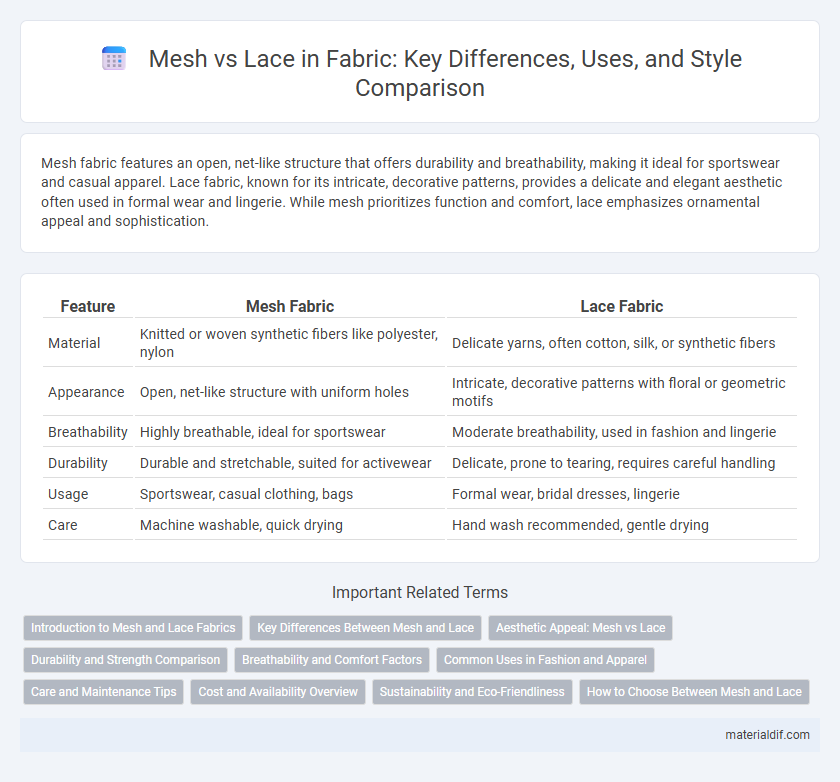Mesh fabric features an open, net-like structure that offers durability and breathability, making it ideal for sportswear and casual apparel. Lace fabric, known for its intricate, decorative patterns, provides a delicate and elegant aesthetic often used in formal wear and lingerie. While mesh prioritizes function and comfort, lace emphasizes ornamental appeal and sophistication.
Table of Comparison
| Feature | Mesh Fabric | Lace Fabric |
|---|---|---|
| Material | Knitted or woven synthetic fibers like polyester, nylon | Delicate yarns, often cotton, silk, or synthetic fibers |
| Appearance | Open, net-like structure with uniform holes | Intricate, decorative patterns with floral or geometric motifs |
| Breathability | Highly breathable, ideal for sportswear | Moderate breathability, used in fashion and lingerie |
| Durability | Durable and stretchable, suited for activewear | Delicate, prone to tearing, requires careful handling |
| Usage | Sportswear, casual clothing, bags | Formal wear, bridal dresses, lingerie |
| Care | Machine washable, quick drying | Hand wash recommended, gentle drying |
Introduction to Mesh and Lace Fabrics
Mesh fabric features an open weave structure, creating a net-like appearance that offers breathability and durability, commonly used in sportswear and lingerie. Lace fabric consists of intricate patterns crafted through looping or twisting threads, providing an elegant, decorative look ideal for bridal wear and evening gowns. Both fabrics serve distinct purposes, balancing functionality and aesthetic appeal in textile design.
Key Differences Between Mesh and Lace
Mesh fabric features an open knit structure characterized by its durability and breathability, making it ideal for sportswear and outdoor gear. Lace fabric, composed of intricate patterns and often made from delicate threads like cotton or silk, emphasizes decorative aesthetics suitable for formal attire and lingerie. The key differences lie in mesh's functionality and strength versus lace's ornamental design and lightweight texture.
Aesthetic Appeal: Mesh vs Lace
Mesh fabric offers a modern, sporty aesthetic with its open weave and geometric patterns, creating a sleek and breathable look ideal for activewear and casual styles. Lace provides an intricate, elegant appearance characterized by delicate floral or ornamental designs, adding sophistication and romantic charm to formal and bridal garments. The choice between mesh and lace significantly influences the visual texture and style of clothing, balancing between contemporary minimalism and classic refinement.
Durability and Strength Comparison
Mesh fabric offers higher durability and strength compared to lace due to its tightly woven structure made from synthetic fibers such as nylon or polyester. Lace, often crafted from delicate threads like cotton or silk, excels in aesthetic appeal but lacks the tensile strength and abrasion resistance seen in mesh. For applications requiring long-lasting performance and resilience, mesh provides superior toughness and structural integrity over lace.
Breathability and Comfort Factors
Mesh fabric offers superior breathability due to its open weave structure, allowing for enhanced air circulation and moisture wicking. Lace, while breathable, tends to have a denser pattern and may not provide the same level of airflow, making it less effective in moisture management. Comfort in mesh is often preferred in activewear because it reduces heat buildup, whereas lace is typically favored for aesthetic appeal in fashion garments.
Common Uses in Fashion and Apparel
Mesh fabric is widely used in activewear and sports apparel due to its breathability and moisture-wicking properties, making it ideal for athletic jerseys, sneakers, and workout tops. Lace, characterized by its intricate, openwork patterns, is predominantly featured in formal wear, bridal gowns, and lingerie to add elegance and texture. Both fabrics serve distinct fashion purposes: mesh emphasizes functionality and comfort, while lace prioritizes decorative appeal and sophistication.
Care and Maintenance Tips
Mesh fabric requires gentle washing with cold water and air drying to maintain its breathable texture and prevent snagging, while lace demands delicate hand washing with mild detergent to preserve its intricate patterns and avoid tearing. Both fabrics benefit from storing flat or on padded hangers to avoid stretching and distortion. Avoid harsh chemicals and high heat during ironing or drying to extend the lifespan of mesh and lace textiles.
Cost and Availability Overview
Mesh fabric generally offers a more cost-effective option than lace due to its simpler manufacturing process and wider availability in mass markets. Lace, often handmade or produced with intricate patterns, tends to be more expensive and less accessible, especially in unique or luxury designs. Availability of mesh fabrics spans from budget-friendly retail stores to online suppliers, while lace is frequently found in specialty shops or high-end fabric outlets, influencing overall pricing and procurement convenience.
Sustainability and Eco-Friendliness
Mesh fabric, often made from synthetic fibers like polyester or nylon, poses challenges for sustainability due to its reliance on petrochemical sources and limited biodegradability. Lace, traditionally crafted from natural fibers such as cotton or silk, offers a more eco-friendly alternative with better biodegradability and lower environmental impact during production. Choosing lace over synthetic mesh supports sustainable fashion by reducing microplastic pollution and promoting renewable material use.
How to Choose Between Mesh and Lace
Choosing between mesh and lace depends on the desired fabric functionality and aesthetic appeal; mesh offers breathability and durability, making it ideal for sportswear and casual outfits, while lace provides intricate patterns and delicate texture suited for formalwear and decorative accents. Consider the occasion and comfort needs--mesh supports ventilation and flexibility, whereas lace emphasizes elegance and style. Evaluating the fabric blend, maintenance, and garment use will guide the decision for either mesh or lace in textile applications.
mesh vs lace Infographic

 materialdif.com
materialdif.com